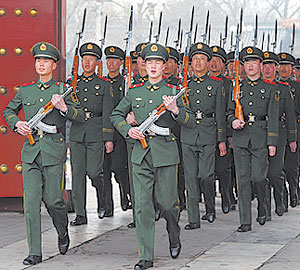Military machine: Learning to use new equipment

Roula Khalaf, Editor of the FT, selects her favourite stories in this weekly newsletter.
When fighter jets took off from the Liaoning, China’s first aircraft carrier, for the first time late last month, video footage of the airmen’s Top Gun-like gestures went viral on domestic websites.
With hundreds of amateur videos offering imitations of the moves, an aircraft carrier style craze is sweeping China, much like the Gangnam Style phenomenon – of Korean pop star Psy – elsewhere.
Some 14 years after the country bought the Soviet-designed carrier as an unfinished hull from Ukraine, the People’s Liberation Army is learning to operate it. For many Chinese, this is a symbol of national pride.
For the armed forces themselves, it indicates a new phase of development.
Following more than a decade of double-digit annual increases in military spending, much of which is believed to have gone into the acquisition and development of new weapons, the PLA now has to learn to use the new equipment.
In the case of the carrier, Andrew Erickson, an expert on the Chinese military at the US Naval War College, says: “Once again China has exceeded the expectations of many foreign observers regarding timelines for military capabilities development, though the tremendous publicity the event has received could limit the country’s ability to move with such speed in developing its aircraft carrier.”
Military officers from other countries that own aircraft carriers have pointed out repeatedly that learning to operate carriers will be very challenging and China’s carrier operations will not pose a threat to anyone for many years to come.
The PLA, meanwhile, is making ready several other large pieces of military hardware.
Last month, China surprised external observers with the flight test of its second Stealth fighter model in as many years. The deployment of a locally developed land-based anti-ship missile – dubbed the “carrier killer” for its potential to put US carrier groups in the region at risk – is also under way.
More incrementally, but most clearly felt by China’s neighbours, the PLA navy has been continuously increasing the frequency, reach and level of sophistication of patrols and exercises, deploying new submarines, destroyers and other ships.
These manoeuvres have alarmed and caused friction with Japan, Taiwan, some southeast Asian countries and the US, as China’s navy becomes increasingly active in waters subject to numerous territorial disputes.
This year, a Chinese warship ran aground at Scarborough Shoal amid a stand-off with the Philippines over the spit of land in the South China Sea to which Beijing and Manila lay claim.
Japan regularly reports growing formations of Chinese warships passing through the Miyako Strait, a gap in a chain of Japanese islands, for manoeuvres in the Pacific Ocean.
Explaining the PLA navy’s latest western Pacific exercise, which comes at a time of heightened tension with Japan over the disputed Senkaku, or Diaoyu, islands nearby, a Chinese military spokesman said on November 29 that such drills would continue as they conformed with international law.
Over the past decade, Beijing’s refusal to talk openly about details of its military strategy and military modernisation plans has often triggered concern and suspicion.
Senior US military officials have said China’s military modernisation appeared not to conform with its stated aim of a purely defensive strategy.
But Beijing is changing its tune. At the ruling Communist party’s 18th national congress, which picked a new political and military leadership last month, Hu Jintao, the outgoing president and party chief, indicated that there would be greater clarity about the role of the Chinese armed forces and the country’s military ambitions.
While past statements on Chinese military strategy have focused on its defensive nature, Mr Hu’s work report, which was drafted by a group led by his successor Xi Jinping, called for “building strong national defence and powerful armed forces that are commensurate with China’s international standing”.
Chinese analysts say China need not worry about concerns over its military prowess. “Nobody calls the US and Russia a threat because their military is so powerful that people fear they will come after you if you say something,” says Yang Yi, a former professor at the national defense university, the Chinese military’s main academic training institution.
“When China’s military power has increased to a certain level, things will change for us as well. Don’t be afraid of people talking.”
Mr Yang argues that China should become more open about its military modernisation. “We should tell people how many aircraft carriers we are going to build – four or five,” he says.
“That will put the great powers at ease and crush the small countries’ hopes [that they could provoke us].”
Comments